What qualifies a lizard as a good pet? These species have been ranked by size, ease of care, handleability, personality, and availability. Whether you are choosing your first pet lizard or adding another reptilian friend to your family, we hope that we can help you make an educated decision on what species may be right (or wrong!) for you.
This list is not an all-inclusive care guide; it is just meant as an introduction to commonly kept species and their suitability as captive pets. Any pet lizard requires thorough research of care requirements and much consideration before the purchase, not after you have brought one home!
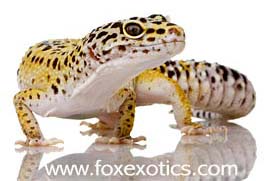
#1 - Leopard Gecko
The leopard gecko, Eublepharis macularius, is probably the most popular pet reptile in captivity today. These small lizards are available in a variety of pleasing colors and patterns. Their care requirements are very simple and they are generally docile and easily tamed.
Because they are nocturnal, they have no special lighting requirements which are common for other lizards. Babies must be fed daily but adults can be fed every other day and left alone for a few days at a time without issue. These hardy, long-lived little lizards make an ideal first reptilian pet.
Lifespan: 15-20+ years
Size: 7-10 inches
Minimum Cage size as adults: 20 gallon tank or equivalent
Special Care Requirements: Controlled heating
Pros: Inexpensive, easy to find, no special lighting requirements, non-threatening look, small and space-efficient
Cons: Insectivorous, need a constant supply of crickets, waxworms, and mealworms in the home.
Further Reading:
The Leopard Gecko Manual: Includes African Fat-Tailed Geckos (Advanced Vivarium Systems)
Leopard and Fat-Tailed Geckos (Reptile and Amphibian Keeper's Guides)
The Beginner's Guide to Leopard Gecko Care: A Simple, Practical Guide to Raising a Happy Leopard Gecko
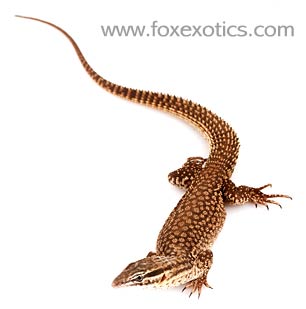
#2 - Red Ackie
Varanus acanthuras, or the "ackie" as it is more commonly called, is also known as the ridge-tailed lizard and spiny-tailed lizard. This small monitor is a true dwarf and is an ideal captive with very straightforward care requirements. If you are looking for a pet monitor this lizard is for you!
Beautifully colored and with the look of little dragons, these active lizards are fun to watch and care for. Ackies can be held on a daily basis and usually tame very well. Ackies can be fed every other day and will accept a variety of foods including crickets and pinky mice
Lifespan: 10+ years
Size: 16-26 inches
Minimum Cage size as adults: 55 gallon tank or equivalent
Special Care Requirements: Controlled heating, UVB lighting
Pros: Relatively small, hardy, docile, unique look
Cons: More expensive than other 'beginner' lizards, can be difficult to find.
Further Reading: Note: There are no books currently available on ackies in particular, but some books on small monitor care can be substituted for proper care information.
Savannah Monitors: A Complete Guide to Varanus Exanthematicus and Others (Complete Herp Care)
General Care and Maintenance of Popular Monitors & Tegus (Herpetocultural Library, The)
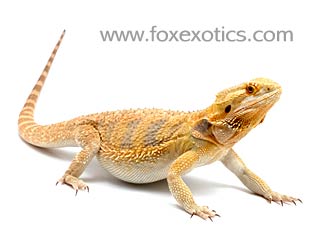
#3 - Bearded Dragon
Bearded dragons, or "beardies" as they are affectionately known, are a great first pet lizard. Their docile demeanor, relatively small size, and straightforward care requirements have earned them a high rank on our best pet list.
Bearded dragons are active during the day and make great display animals. Their trusting, laid back nature allows for easy handling and a great introduction to reptiles even for those who are hesitant or afraid of snakes and lizards.
Lifespan: 8-10 years
Size: 14-24 inches
Minimum Cage size as adults: 40 gallon tank or equivalent
Special Care Requirements: Daily access to special UVB lighting, controlled heating, babies are particularly delicate though adults are very hardy.
Pros: Inexpensive, easy to find, limited care requirements, endearing looks good for converting non-reptile lovers.
Cons: Omnivorous, requiring both insects and vegetation in their diet and fresh greens every day.
Further Reading:
The Bearded Dragon Manual (Advanced Vivarium Systems)
Bearded Dragons (Reptile and Amphibian Keeper's Guides)
Bearded Dragons: A Complete Guide to Pogona Vitticeps (Complete Herp Care)
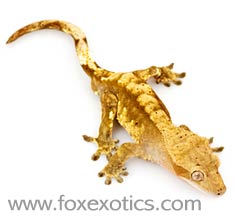
#4 - Crested Gecko
The crested gecko, Rhacodactylus ciliatus, is quickly gaining popularity in the pet trade, for good reason. So called "cresties" have some of the most simple care requirements of any lizards. They need no special heating or lighting; in fact, temperatures above 80 degrees F will stress them. They can be fed simple, packaged, fruit-based powders mixed with water; meaning no insects or difficult diets to worry about!
Crested geckos come in a variety of colors and patterns, from stripes to spots to everything in between. They are handleable and can be easily tamed but are small and more delicate than the larger lizards. They are prone to the accidental loss of their tails which will not harm them but will not regrow.
Lifespan: 5-15 years
Size: 5-8 inches
Minimum Cage size as adults: 20 gallon tank or equivalent
Special Care Requirements: Natural or fake foliage for climbing and hiding
Pros:Most simple of lizard care requirements; no supplemental heating or lighting, simple mix-with-water diet
Cons: Spend a lot of time hiding, nocturnal, more delicate to handle.
Further Reading:
Crested Geckos: From the Experts at Advanced Vivarium Systems
Crested Geckos: A Complete Guide to Rhacodactylus (Complete Herp Care)
Rhacodactylus: The Complete Guide to their Selection and Care
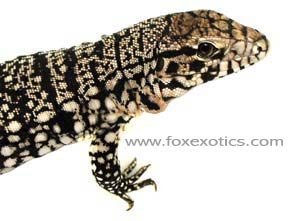
#5 - Argentine Black and White Tegu
The Argentine black and white tegu, Tupinambis merianae, is the largest lizard on our best pet list. It is important to note that adult tegus require more space than the average owner is willing to provide, but if that isn't an issue for you then a tegu might be a great choice as a pet lizard.
Tegus are one of the smartest reptiles, able to learn simple tricks and to respond to the sound of their names. Typically calm, tegus properly socialized from a young age can learn to walk on a harness and be handled with great frequency.
It should be noted that there are multiple tegu species; Columbian tegus are NOT recommended as a good pet lizard. These black and white cousins are often aggressive and difficult to care for.
Lifespan: 15+ years
Size: 3-4.5 feet
Minimum Cage size as adults: 4-6 foot x 2 foot wide cage or larger (larger necessary for adult males.)
Special Care Requirements: UVB lighting and controlled heat, substrate to burrow in.
Pros:Intelligent, captivating, hardy
Cons: Large size and caging requirements.
Further Reading:
General Care and Maintenance of Popular Monitors & Tegus (Herpetocultural Library, The)
Monitors, Tegus, and Related Lizards (Barron's Complete Pet Owner's Manuals)
Worst Starter Pet Lizards
What qualifies a lizard as a bad pet? Many commonly available reptiles, unfortunately, are just not suited for an life in captivity. Just because a lizard is inexpensive or regularly seen in pet shops does not mean it will make a good pet.
Large size, bad temperaments, aggressiveness, difficult care requirements, and many other factors were taken into account in the creation of this list of "bad pet" lizards. As a note, we are not saying that these species should never be kept, but that they are more difficult and suited for advanced, experienced keepers only.
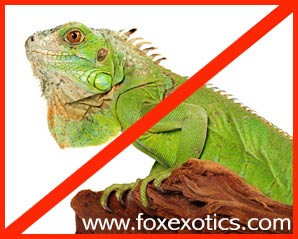
Iguana
Green iguanas are one of the most common and inexpensive reptiles available on the market today, which is a shame. These beautiful lizards are intelligent and sociable but they get BIG. 5-6 feet of razor sharp spikes, talons, and teeth big. Even tame iguanas can cause nasty cuts and slashes by accident and should only be handled by adults.
Iguanas require caging half the size of a standard bedroom and specialized heating/lighting. The cute, small babies grow fast and planning to "upgrade someday" does not work for them. Because of the huge requirement for time and space that iguanas require, they are at the top of our "bad pet" choices.
Lifespan: 15-20+ years
Size: 5-6 feet
Minimum Cage size as adults: 6 x 6 x 6 ft bare minimum
Special Care Requirements: Controlled heating, lighting, vegetable diet
Pros: Inexpensive, easy to find
Cons: Size, aggressiveness (if not regularly handled or with breeding males), big commitment, high maintenance.
Further Reading:
Green Iguana: The Ultimate Owner's Manual
The Green Iguana Manual (Advanced Vivarium Systems)
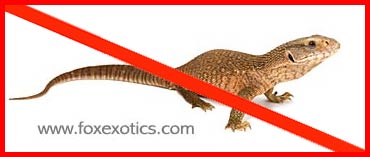
Savannah Monitor
The savannah monitor, Varanus exanthematicus, is available readily and inexpensively, with many babies $25 or less. This is truly unfortunate because they grow into large, powerful lizards capable of inflicting a nasty bite and even breaking bones with a tail whip and the low cost creates a lot of uninformed impulse buys and abandoned adult lizards. They are one of the better pet monitors but are not for the beginning keeper.
Savannah monitors require huge cage spaces and experienced handling. The eat a lot and have to be cleaned up after daily, not a pleasant task. They are intelligent escape artists and can cause immense amounts of property damage. Keeping a large monitor is a huge commitment of time and resources and should not be taken lightly.
Lifespan: 10-15+ years
Size: 3-4 feet
Minimum Cage size as adults: 4 foot x 8 foot x 4 foot minimum
Special Care Requirements: Controlled heating, lighting, humidity
Pros: Inexpensive, easy to find, relatively even tempered compared to many other monitors
Cons: Large size, messy, resource intensive.
Further Reading:
Savannah Monitors: A Complete Guide to Varanus Exanthematicus and Others (Complete Herp Care)
General Care and Maintenance of Popular Monitors & Tegus (Herpetocultural Library, The)
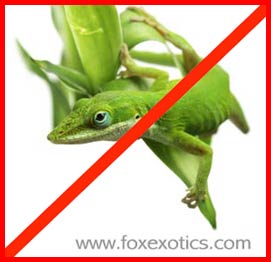
Green Anole
The green anole is extremely common and very inexpensive to purchase. This price is misleading, however; they have care requirements including expensive lighting and controlled environments that can cost dozens of times the initial purchase price of the lizard itself.
Though pretty, anoles are easily stressed and should not be handled on a regular basis. They are carnivorous and need daily insect feedings as juveniles and every other day as adults. They can be easily kept with a proper setup, but because of their flighty nature and specific care requirements please think twice before picking one up as a "cheap pet".
Lifespan: 3-5 years
Size: 5-8 inches
Minimum Cage size as adults: 10-20 gallon tank or equivalent
Special Care Requirements: Controlled heating, UVA and UVB lighting
Pros: Inexpensive, easy to find, small
Cons: Expensive setup, easily stressed
Further Reading:
Anoles: Facts & Advice on Care and Breeding (Reptile Keeper's Guides)
Green Anoles: From the Experts at Advanced Vivarium Systems

Chameleon
Chameleons can do well in captivity but their very specific, generally unforgiving, care requirements place them on our list of lizards best kept for more advanced handlers. Chameleons available in pet stores are often wild caught and difficult to care for, carrying a variety of parasites and diseases. Captive bred animals are a must.
Though chameleons are beautiful, they are best not being handled unless it is an absolutely necessary as they are easily stressed or hurt. They need very high humidity and a specially set up terrarium with natural or fake plants and ideally with an automatic misting system. Chameleons can make wonderful, fascinating pets but they require much more research, commitment and care than many other lizard species.
Lifespan: 2-5 years
Size: Variable
Minimum Cage size as adults: Variable as per species
Special Care Requirements: Controlled lighting, specific humidity requirements
Pros: Fascinating, unique
Cons: Expensive setup, easily stressed, non-handleable
Further Reading:
Essential Care of Chameleons (Herpetocultural Library)
Chameleons (Barron's Complete Pet Owner's Manuals)
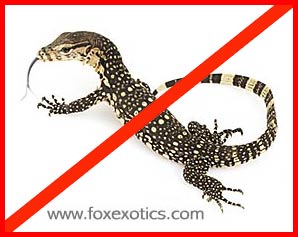
Other Monitors
There are a variety of commonly available monitor species including nile monitors, asian water monitors, green tree monitors, and others. Almost all of these make poor captives, getting to overly large sizes or being very delicate in their environmental needs.
If you are interested in a pet monitor, please do thorough research on your species of interest. Monitors are intelligent, long lived lizards and that inexpensive baby may cause thousands of dollars to house properly. Large monitors also eat large prey and produce large feces. Many are at least as time consuming to properly care for as a dog. Wild-caught imports are most common in pet stores and often carry parasites that can be expensive to treat. Don't be swayed by cheap price tags and small, cute babies!
Lifespan: Variable
Size: Variable
Minimum Cage size as adults: Variable as per species, generally very large
Special Care Requirements: Controlled lighting, specific humidity requirements, controlled heating
Pros: Beautiful, intelligent, interesting
Cons: Expensive setup, aggressive, difficult to care for
Further Reading:
General Care and Maintenance of Popular Monitors & Tegus (Herpetocultural Library, The)
Monitors, Tegus, and Related Lizards (Barron's Complete Pet Owner's Manuals)
















